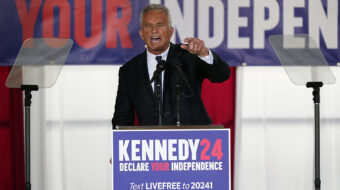
CHICAGO – Images of city life, labor, and the workplace, and protests against social injustice are among the fine-art prints in an exhibition at the DePaul Art Museum.
The 56 prints in the exhibition were produced during the Depression, when the federal government was providing financial support to a wide range of artistic projects, from fiction to fine art, through the Works Progress Administration-Federal Arts Project (WPA-FAP).
The WPA was established April 8, 1935, under the Emergency Relief Appropriation Act, as a means of creating meaningful public works jobs for the nation’s millions of unemployed. Under the direction of Harry Hopkins, the WPA employed more than 8.5 million people on 1.4 million public projects before it was disbanded in 1943.
Among the WPA’s most famous programs are those that put writers, artists, musicians, actors and directors to work: the Federal Art Project, the Federal Theatre Project, and the Federal Writers Project. Among their products are the now-legendary public murals that still grace post offices and other public spaces around the country, as well as regional guidebooks that have become valuable cultural and historic sources.
“The prints are a window into the 1930s, a turbulent and complex time in American history,” said curator Louise Lincoln, director of the museum on DePaul University’s Lincoln Park Campus. “It’s easy to see the hardships in the lives of ordinary people, the social and political controversies, even the disagreements among artists about what the role of art should be,” she said.
Many works addressed the nation’s economic inequality, leading some politicians to denounce the WPA as “subversive,” according to Lincoln. A 1938 story in the Chicago Tribune called it “a vampire political machine,” she said. Under the editorship of Colonel Robert R. McCormick the paper was aligned with the right-wing in its coverage of political news and social trends, attacking the New Deal and enthusiastic for the notorious Sen. Joseph McCarthy.
Many artists and critics believed that the WPA had helped to develop something distinctly American in American art, and artists were deeply grateful for the opportunity to earn their livelihood, Lincoln said. Franklin D. Roosevelt predicted, “one hundred years from now my administration will be known for its art, not for its relief programs.”
The exhibition includes works by such well-known artists as Stuart Davis and Rockwell Kent, and is drawn from a donation of 100 prints to the museum from the collection of Belverd Needles Jr. and Marian Powers Needles. “This wonderfully generous gift carves out a new area in the museum’s collection, and will provide a rich source of exploration and enjoyment for our students and visitors,” Lincoln said.
On Oct. 15, Liz Seaton, curator at Kansas State University’s Beach Museum of Art, will present a lecture on political content in the prints. The lecture begins at 5:30 p.m. All events are free and open to the public.
Ink, Paper, Politics: WPA-era Printmaking from the Needles Collection runs through Dec 21.
The DePaul Art Museum at 935 W. Fullerton, just east of the CTA Fullerton ‘L’ stop, is open Wednesday and Thursday from 11 a.m. to 7 p.m., Friday from 11 a.m. to 5 p.m., and Saturday and Sunday from noon to 5 p.m. The museum is closed Mondays and Tuesdays. For more information, call 773-325-7506 or visit www.depaul.edu/museum.
Photo: Sanding the Propeller, 1941, by Edward Arthur Wilson. Courtesy DePaul Art Museum

MOST POPULAR TODAY


Zionist organizations leading campaign to stop ceasefire resolutions in D.C. area

Communist Karol Cariola elected president of Chile’s legislature

Afghanistan’s socialist years: The promising future killed off by U.S. imperialism

High Court essentially bans demonstrations, freedom of assembly in Deep South






Comments